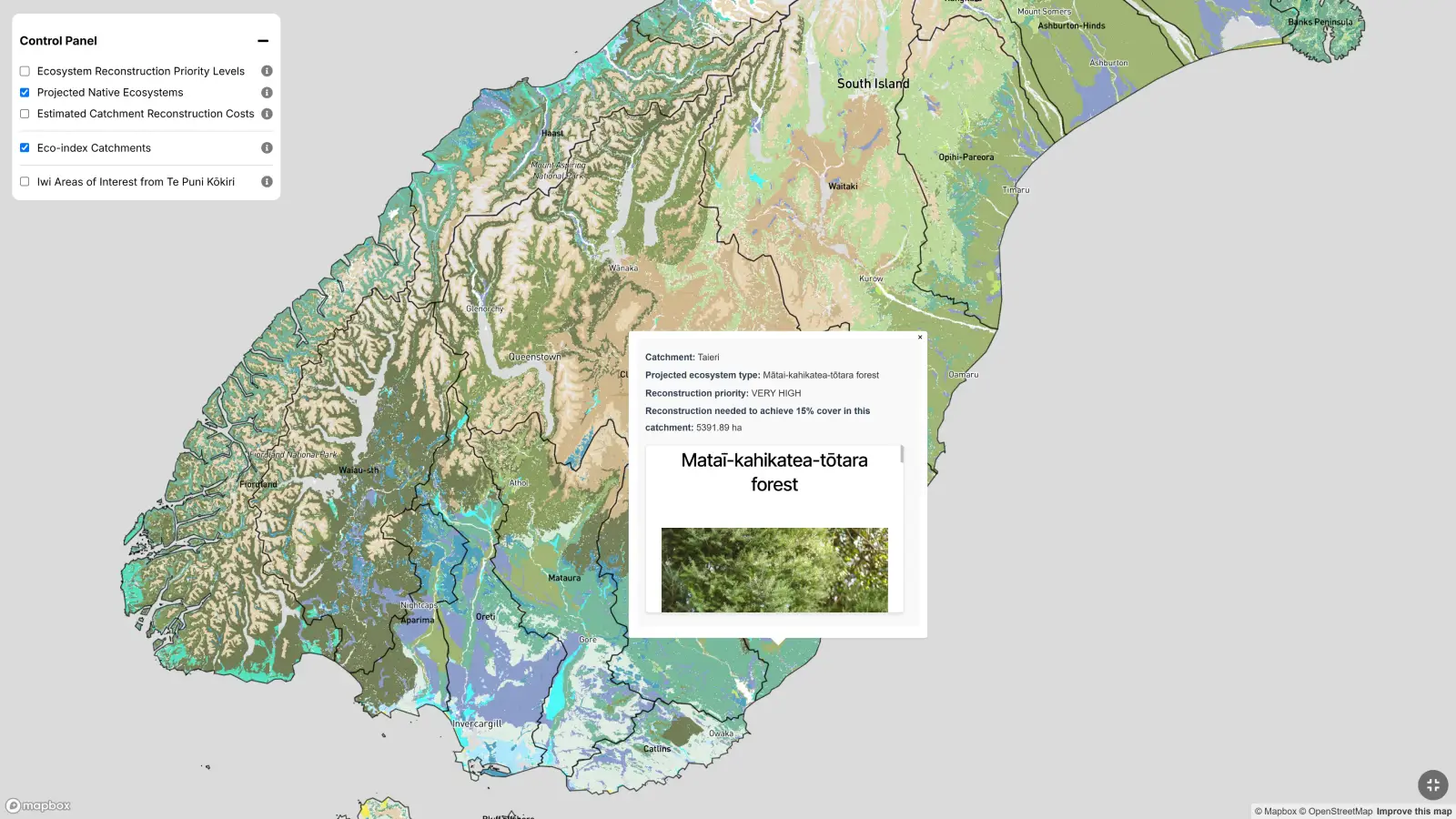The cost of reconstructing enough native habitat for nature to thrive across New Zealand has been estimated by the Eco-index research programme and published in an update to its online Ecosystem Reconstruction Map.
Ecosystem reconstruction involves recreating native habitat in areas where it has been completely removed. This often occurs in retired pasture, in urban parks or along waterways and usually involves planting native trees and shrubs alongside weed and pest control.
The first version of the Eco-index Ecosystem Reconstruction Map was launched in November 2023 to share information about the need to not only look after existing ecosystems but reconstruct missing ones too.
“Biodiversity in Aotearoa is in decline,” says Eco-index Co-Director Dr Kiri Joy Wallace from the University of Waikato. “We want to understand where we can most effectively invest in reversing this trend.”

Dr Kiri Joy Wallace
Last month, for version 2.0 of the map, the team put a price tag on the ecosystem reconstruction required for each catchment to reach at least 15% cover of their local ecosystem types. These estimates include the cost of purchasing native plants, fencing and three years’ worth of non-native plant control, when the native plantings are most vulnerable to being smothered.
“This broad-scale costing is based on information we’ve collected from across the country for ecosystem reconstruction of different native ecosystem types. It is intended as a guide to highlight the current funding gap for biodiversity in Aotearoa,” Dr Wallace says.
She says she hopes that the addition of costings to their public map – which for most catchments is a multi-billion-dollar amount – will also help people realise that ecosystem reconstruction is expensive, so it is important to value and protect what ecosystem cover they already have.
The timing of releasing the new costings is poignant too, Dr Wallace says, coming as the Department of Conservation turns to private and philanthropic donations to fill conservation funding gaps amid government budget cuts.
“Funding shortfalls for nature are not only an issue in Aotearoa New Zealand,” Dr Wallace says, referring to a 2020 report led by The Nature Conservancy which identified a global biodiversity finance gap of between US $598 and 824 billion per year.
“The cost estimate we have made available is helpful for raising awareness, but it isn’t the whole story. Some ecosystem reconstruction methods may be more cost effective than our estimates, such as those that can make the most of natural regeneration, while it is imperative that the costs to protect and restore existing native ecosystems are considered.”

Estimated costings for catchment-scale ecosystem reconstruction reflect the funding gap for biodiversity in New Zealand.
The Ecosystem Reconstruction Map also shows users where reconstructing native ecosystems is the highest priority, what kind of ecosystems are appropriate where and how many hectares need to be reconstructed to reach the 15% cover goal.
A grant from Biome Trust – an international philanthropic organisation focused on supporting environmental projects – helped Eco-index to launch version 2.0 of the map.
Matthew Monahan, Co-Steward of Biome Trust says, “We are pleased to support Eco-index to provide cutting-edge intelligence for land planning and biodiversity investment. Their work to bring data and technical expertise together is important for many large-scale environmental projects.”
As well as adding cost information to the map, the Biome Trust grant has helped Eco-index to develop and share two digital products that organisations can use to harness the reconstruction map’s data within their own systems. These have so far been provided for free to Te Arawa Lakes Trust and Taranaki Mounga Project.
Eco-index was initiated through the collaborative Biological Heritage National Science Challenge, but with funding from the National Science Challenges having come to an end earlier this year, it now exists as a purpose-driven limited company associated with a charitable trust.
The charitable grant from Biome Trust has been one way that Eco-index and its products have continued to evolve and be provided free of charge to the public and community groups.
“Because our research is taking off and people are picking up the outputs and taking an interest in it, we're trying to stay together as a team to keep doing this kind of research and support this platform,” Dr Wallace says.
“We’re lucky we have some good philanthropists in the country who are interested in funding the development of these kinds of technologies – we were really grateful to get this grant from Biome Trust.”
Alongside Dr Wallace, who is an ecologist, the Eco-index team includes data scientists, an environmental economist, an impact analyst and sustainability experts.
“Together we’re weaving data into these tools that people can use, to hopefully help biodiversity and counter some of the loss.”
Dr Wallace says she finds this applied research, which takes data to the world in an easy-access way, stokes her fire.
“It seems like a lot of academic pursuit and investment never leaves the ivory tower to make the world better. I’ve found that a bit frustrating in the past and love this aspect of taking data to the world in this applied, easy-access way to hopefully make a difference.”




